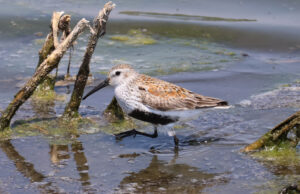A narrow road in rural Livingston County was getting a lot of attention in early April. Several cars were along the shoulder, and people stood at the roadside with spotting scopes and binoculars peering across a field. The focus of their attention was a patch of wet ground and the myriad migrating shorebirds, which were walking in the shallow water. The pool was larger than a puddle, but smaller than a flooded field. Birders often use the term “Fluddle” to describe these ephemeral wetlands. The farmer of this field sips coffee in the kitchen while looking out the window. Seeing the congregation of birders on the horizon brings a smile. It’s too early to plant the field, but there is still life on the farm.

A Dunlin wades in a roadside fluddle to many a birder’s delight in the marshy bogs near Banner.
PHOTO BY PETE FENNER/PEORIA AUDUBON SOCIETY
In the spring, shorebirds migrate from their wintering grounds in the southern hemisphere to their nesting grounds in the arctic north. In the late summer, they reverse their travels and head south. If there is ample rain to create fluddles, many of the shorebirds (sandpipers, plovers, and their kin) will drop into these fleeting pools to feed during the day. A parallel human migration also happens as birders flock to areas where birds congregate. This interaction between humans and birds caught the attention of Chicago-based filmmaker and producer Bob Dolgan. His company, Turnstone Strategies, seeks out stories to tell. His interest in nature and birding gives him personal insight into the stories that exist between humans and the natural world. He has just completed a new film entitled “Fluddles,” which chronicles the wildlife of agricultural wetlands in Illinois. It is a story of hope in a landscape where more than 90% of our wetlands have been destroyed.
Dolgan has also produced other films including “Monty and Rose,” which documents the return of a nesting pair of endangered Piping Plovers to the popular Montrose Beach along Chicago’s Lake Michigan beachfront. Beyond documenting the ecology of the species, the film tells the story of a community that came to embrace the return of a species, and the challenges that both the pair of birds, and those humans who fell in love with them, faced together. “The Magic Stump” tells the story of an Illinois tree stump that has attracted a remarkable number of birds of prey. It serves as an island in an ocean of farmland and highlights the plight of northern raptors that visit the Prairie State during winter. It has served as a perch for rare birds such as Snowy Owls and Prairie Falcons.
Dolgan’s films attempt to thread the needle of highlighting a conservation concern and providing inspirational insights on humans who seek to make a difference. All under the guise of a birding film. It is a very effective storytelling technique and viewers tend to leave a viewing understanding a bit more about themselves in the big picture.

